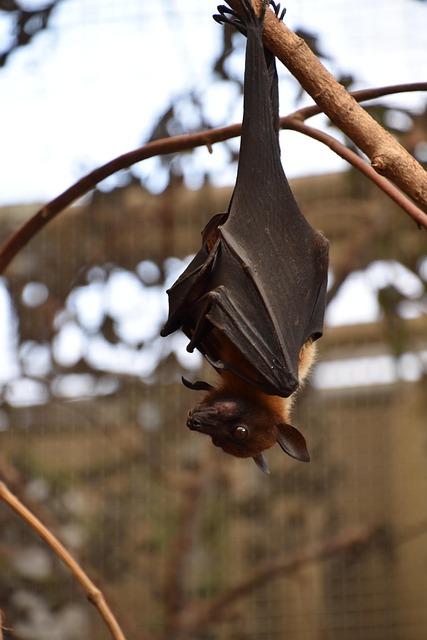Understanding the composition of bat guano highlights the need for humane bat control methods to ensure safe and healthy living environments. This involves protective gear, specialized cleaning, and proper ventilation to mitigate health risks from dust and pathogens. Excluding bats through sealed entry points, thorough inspections, and one-way devices during appropriate seasons is crucial. Post-exclusion, professional disinfection with hospital-grade disinfectants prevents health hazards from remaining bacteria and fungi in guano. Proactive property inspection and seasonal checks, along with exclusion strategies, maintain a balanced ecosystem while keeping both humans and bats safe.
Bats and their droppings, or guano, can pose health risks, but humane bat control is essential for a healthier living environment. This guide explores the intricate process of safely removing bat droppings, understanding their composition, and mitigating potential hazards. Learn effective strategies for humane bat removal, from non-lethal techniques to ensuring thorough disinfection post-exclusion. Additionally, discover preventive measures to seal your space against future invasions, promoting a clean and safe living area.
Understanding Bat Guano: Its Composition and Potential Health Risks
Bat guano, or droppings, may seem like a mere nuisance but understanding its composition is key to safe removal and humane bat control. It’s a complex mixture of different components, including uric acid, nitrogen, and calcium, which can make it highly corrosive and potentially hazardous if not handled properly. While bats are beneficial for ecosystem balance, their droppings can lead to various health risks for humans.
Exposure to guano can cause respiratory issues due to the dust particles it generates. Additionally, bats can carry diseases such as rabies, making guano removal a critical task. Implementing humane bat control methods involves wearing protective gear and using specialized cleaning techniques to minimize the spread of pathogens. Proper ventilation is essential during the process to prevent inhalation of toxic fumes.
Humane Bat Removal: Strategies for Safe Eviction
When dealing with bat droppings, also known as guano, it’s essential to employ humane bat control methods for safe and effective removal. This involves understanding bat behavior and habitat preferences to ensure their well-being during the eviction process. One strategy is to seal entry points, blocking any access to the building while allowing bats to exit naturally at dawn or dusk. It’s crucial to inspect the property thoroughly, identifying all potential roosting sites, as bats often return to familiar spaces.
Using humane techniques, like one-way exclusion devices, allows bats to leave but prevents reentry. This process should be conducted during the proper season, avoiding any potential harm to the bats or disruption to their ecological role. Additionally, professional bat removal services specializing in humane control can offer expert guidance and ensure compliance with local regulations, promoting a healthier environment for both the occupants and these nocturnal creatures.
Effective Disinfection and Decontamination Post-Bat Exclusion
After safely excluding bats from your space through humane bat control methods, ensuring effective disinfection and decontamination is crucial for maintaining a healthier environment. Bat droppings, or guano, can harbour harmful bacteria and fungi that pose risks to human health. Professional cleaning services equipped with specialised equipment and disinfectants are recommended to thoroughly clean all affected areas. This includes high-pressure washing, vacuuming, and the use of hospital-grade disinfectants to eliminate any pathogens associated with bat droppings.
Proper ventilation is also essential during the decontamination process to prevent the spread of potentially toxic spores. By following these strict hygiene protocols, you can mitigate health risks and create a safer living or working space while ensuring the humane treatment of bats.
Preventing Future Invasions: Seal Up Your Space
To prevent future invasions and maintain a healthier space, it’s crucial to seal up any entry points bats might have used to get inside. Humane bat control methods emphasize the importance of exclusion rather than eradication. Start by conducting a thorough inspection of your home or building, identifying all potential openings—cracks in walls, gaps around windows and doors, or vents—that could serve as entry points. Seal these areas with appropriate materials like caulk or steel wool to ensure bats can’t re-enter. Regular maintenance and inspections are key; check for new entries during seasonal changes when bats may seek alternative habitats.
In conclusion, addressing bat droppings (guano) through humane bat control methods is essential for maintaining a healthy living environment. By understanding the composition and potential risks associated with guano, implementing safe removal and disinfection practices, and preventing future invasions through proper sealing, folks can ensure their spaces are free from these remnants without causing harm to these crucial ecosystem contributors. Remember that, in today’s digital era, navigating humane bat control is not only beneficial for personal health but also a testament to our commitment to living harmoniously with nature.
